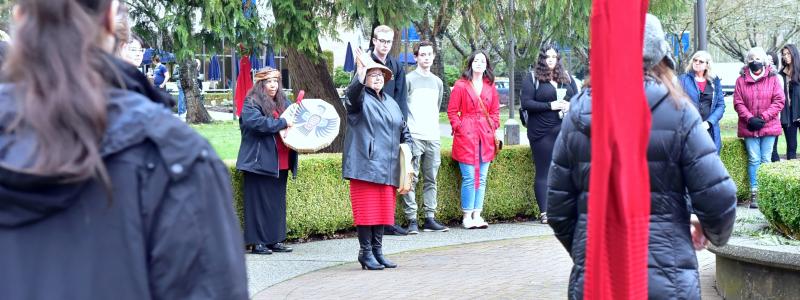As an annual march took place in downtown Vancouver on Monday, February 14, 2022 in honour of missing and murdered women and girls, members of the TWU community gathered at the Remembrance Circle on the Langley campus.
Patti Victor, University Siyá:m and Chair of TWU’s Indigenous Partnership Council, led students, staff and faculty to gather in solidarity, contemplation, prayer and silence.
Inspired by Jaime Black, an artist (of mixed Anishinaabe and Finnish descent) who responded to the more than a thousand missing and murdered Indigenous women across Canada by creating an art installation of red dresses, TWU community members hung empty red dresses on the trees surrounding the Remembrance Circle at the centre of campus
Patti, who is Stó:lō from Cheam First Nation in B.C., opened the ceremony in accordance with traditional Stó:lō protocol, with drumming and songs.
“This is an opportunity for the community to come together to grieve the loss of our beloved sisters, to remember the women who are still missing, and to dedicate ourselves to justice,” she said at the event.
“At TWU we have chosen Feb. 14 and 15 to remember and reflect upon this injustice, and to join [in solidarity] with the Women’s’ Memorial March in downtown Vancouver.”
Patti opened the ceremony with a song in Halq’eméylem, the language of the Stó:lō people. The song, Patti explained, declares that this land is God’s land, “This is God’s place, and it’s by His Spirit that He has gathered us together today, to walk together in a good way, to learn from one another, and to honour God in all that we do and say.”
Those who led alongside Patti Victor included staff member Janet Kreiter, who designed the Story Walk trellises that present the facts about Canada’s missing and murdered Indigenous women, Nursing Instructor Kathleen Lounsbury (of the Kwakwaka'wakw territory), and Resident Director Amanda Seymour (of the Mohawk territory of Akwesasne).
During the ceremony, leaders set up the Story Walk trellises and lay out cedar branches between each trellis. Cedar branches are medicinal and symbolize healing. Within Stó:lō territory, the cedar tree is part of spirituality practices.
Following this, members of the community hung up red dresses, paying tribute to the Indigenous women and girls who are missing and murdered, and their families who grieve. Patti invited the community to stand in a moment of silence and prayer before she closed the ceremony with an honour song.
On Tuesday, Feb. 15, there will be a second event to reflect on Monday’s ceremony and respond to the Calls to Justice from the MMIWG Report. This week, the red dresses will hang on the trees at the Langley campus for awareness and advocacy, and then they will be taken down on Friday in ceremony.
About Red Dress Events at TWU
All TWU students, staff and faculty are invited to the following outdoor events.
Dates:
- Monday, February 14 | 12:00 p.m. | Storywalk
- Tuesday, February 15 | 4:30 p.m. | Remembrance Vigil
Location:
- Remembrance Circle in the center of the Langley campus (the circular garden bed located outside of Douglas Hall)
Program:
- February 14 — We will begin a Storywalk at noon and hang red dresses to symbolize the Indigenous women and girls who are missing or murdered. This ceremony will follow traditional Stó:lō protocol.
- February 15 — We will gather at 4:30 p.m. for a Remembrance Vigil to stand together to listen, to hear, and to pray. As we remember and pray for God’s direction in ways to end the violence, we will learn to walk together in a good way.
See this story in the Langley Advance Times.
To learn more about the reason behind TWU’s Red Dress events, here are some helpful resources:
- Native Women’s Association of Canada (NWAC) has created a database of missing and murdered Aboriginal women and girls. A fact sheet can be found here.
- The National Inquiry into Missing and Murdered Indigenous Women and Girls (MMIWG) report is found here.
Note to participants:
- You are welcome to please gather red dresses (with hangers) to bring to the gathering on February 14 and to encourage others to join in the ceremonies.
- You may want to read the MMIWG Report and the calls to justice ahead of time and consider which calls to justice apply to education and how are they being applied.
- You may want to have some conversations around white privilege; taking responsibility for the systems that benefit or privilege some, while oppressing or marginalizing others.
We look forward to our time together as a TWU community.
Trinity Western University, Langley campus is located on the traditional ancestral unceded territory of the Stó:lō people.
About Trinity Western University
Founded in 1962, Trinity Western University is Canada’s premier Christian liberal arts university dedicated to equipping students to establish meaningful connections between career, life, and the needs of the world. It is a fully accredited research institution offering liberal arts and sciences, as well as professional schools in business, nursing, education, human kinetics, graduate studies, and arts, media, and culture. It has four campuses: Langley, Richmond-Lansdowne, Richmond-Minoru, and Ottawa. TWU emphasizes academic excellence, research, and student engagement in a vital faith community committed to forming leaders to have a transformational impact on culture. Learn more at www.twu.ca or follow us on Twitter @TrinityWestern, on Facebook and LinkedIn.

